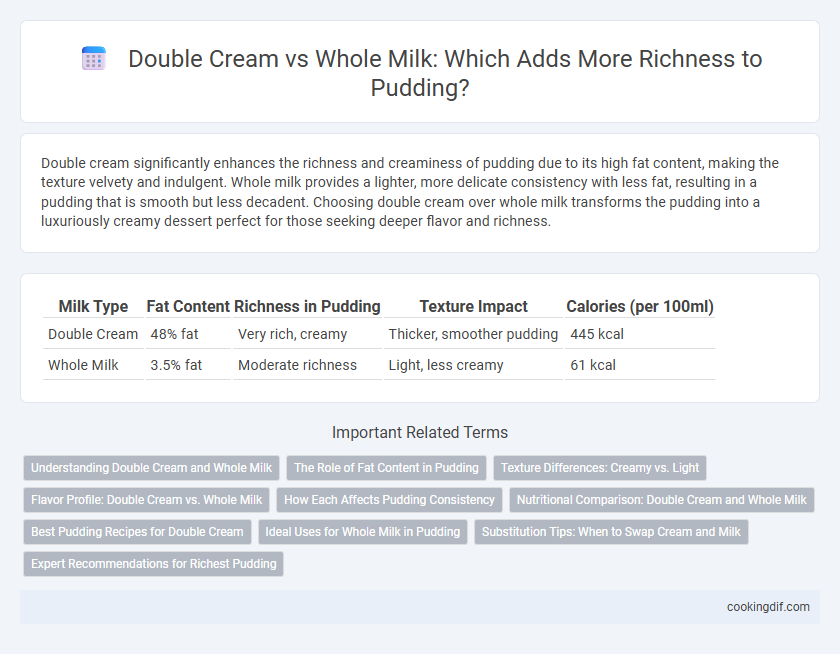Double cream significantly enhances the richness and creaminess of pudding due to its high fat content, making the texture velvety and indulgent. Whole milk provides a lighter, more delicate consistency with less fat, resulting in a pudding that is smooth but less decadent. Choosing double cream over whole milk transforms the pudding into a luxuriously creamy dessert perfect for those seeking deeper flavor and richness.
Table of Comparison
| Milk Type | Fat Content | Richness in Pudding | Texture Impact | Calories (per 100ml) |
|---|---|---|---|---|
| Double Cream | 48% fat | Very rich, creamy | Thicker, smoother pudding | 445 kcal |
| Whole Milk | 3.5% fat | Moderate richness | Light, less creamy | 61 kcal |
Understanding Double Cream and Whole Milk
Double cream contains approximately 48% fat, lending a rich, velvety texture and intense creaminess to puddings, while whole milk has about 3.5% fat, providing a lighter consistency with subtle dairy sweetness. The higher fat content in double cream enhances the mouthfeel and helps achieve a thicker, more indulgent pudding, making it ideal for recipes requiring richness and smoothness. Whole milk is better suited for lighter puddings or when a less dense texture is desired, balancing flavor without overwhelming creaminess.
The Role of Fat Content in Pudding
Double cream, with its high fat content of around 48%, significantly enhances the richness and creamy texture of pudding by contributing to a smooth, velvety mouthfeel and preventing curdling during cooking. In contrast, whole milk, containing approximately 3.5% fat, offers a lighter consistency and less depth of flavor, which may result in a thinner, less indulgent pudding. The fat in double cream not only enriches the taste but also stabilizes the pudding's structure, leading to a richer and more luxurious dessert experience.
Texture Differences: Creamy vs. Light
Double cream enhances pudding with a luscious, velvety texture that creates a rich and indulgent mouthfeel, ideal for thicker, creamier desserts. Whole milk produces a lighter, silkier pudding, offering a more delicate consistency that highlights subtle flavors without overwhelming the palate. The choice between double cream and whole milk significantly influences the pudding's texture, balancing richness and lightness according to desired dessert characteristics.
Flavor Profile: Double Cream vs. Whole Milk
Double cream imparts a luxurious, velvety texture and a rich, buttery flavor that elevates the pudding's depth and mouthfeel, creating a more indulgent dessert experience. Whole milk offers a lighter, creamier base with subtle sweetness, allowing other ingredients' flavors to shine through without overpowering. The choice between double cream and whole milk significantly influences the pudding's overall richness and flavor intensity.
How Each Affects Pudding Consistency
Double cream significantly enhances pudding richness by adding a thick, velvety texture and a high fat content that creates a creamy mouthfeel. Whole milk contributes to a lighter, less dense pudding consistency, offering a smoother but thinner result due to its lower fat percentage. The choice between double cream and whole milk directly impacts the pudding's firmness and richness, with double cream producing a more indulgent, stable custard-like texture.
Nutritional Comparison: Double Cream and Whole Milk
Double cream contains approximately 48% fat, providing a rich, creamy texture and significantly higher calories compared to whole milk, which has about 3.25% fat. Whole milk delivers essential nutrients like calcium and vitamin D with fewer calories and less saturated fat, making it a lighter option for pudding. For a richer pudding experience, double cream enhances mouthfeel and flavor intensity while whole milk offers a balanced, nutritious alternative.
Best Pudding Recipes for Double Cream
Double cream significantly enhances the richness and velvety texture of puddings compared to whole milk, adding a luxurious mouthfeel and depth of flavor that whole milk cannot match. The higher fat content in double cream contributes to a thicker, creamier consistency ideal for indulgent desserts like custards and chocolate puddings. Best pudding recipes for double cream include classic creme brulee, rich panna cotta, and silky chocolate mousse, where the cream's decadence elevates every spoonful.
Ideal Uses for Whole Milk in Pudding
Whole milk provides a lighter texture and subtler flavor in pudding, making it ideal for recipes where a delicate, creamy consistency is desired without overwhelming richness. It works best in fruit-based or lighter mousse puddings where the focus is on freshness and natural sweetness. Using whole milk ensures a smooth, velvety pudding while maintaining a balanced richness that complements rather than dominates other ingredients.
Substitution Tips: When to Swap Cream and Milk
Double cream dramatically enhances pudding's richness and creaminess due to its high fat content, making it ideal for indulgent, smooth textures. Whole milk can be substituted when a lighter pudding is desired, but expect less velvety consistency and reduced flavor intensity. When swapping, use approximately half the amount of double cream in place of whole milk to maintain richness without overpowering the pudding's balance.
Expert Recommendations for Richest Pudding
Experts recommend using double cream over whole milk for the richest pudding texture due to its higher fat content, which enhances creaminess and depth of flavor. Double cream typically contains around 48% fat compared to whole milk's 3.5-4%, creating a velvety consistency that whole milk cannot match. For the creamiest and most indulgent pudding, culinary specialists consistently favor double cream as the key ingredient.
Double cream vs Whole milk for richness in pudding Infographic

 cookingdif.com
cookingdif.com